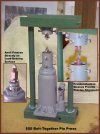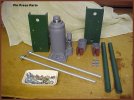- Joined
- Dec 7, 2000
- Messages
- 5,179
Finally got this done. Fellow forumite navajas convinced me I didn't have to weld a pin press together, but could simply bolt it all up. He was right! Roland, thanks for your help.
The pic will hopefully explain most of it. The anvils are hardened and will be simple to change out if needed. If anyone would like to see larger images or a pic of something specific just let me know.
The whole thing cost less than $50. The 12-ton jack is from Harbor Freight on sale for under $30. The most unusual tool I used was a tap and die set; the only tool I bought was to ease my laziness, a 3/4" drill bit. Who wants to file big holes in heavy steel? Not me, for sure.
Dave
The pic will hopefully explain most of it. The anvils are hardened and will be simple to change out if needed. If anyone would like to see larger images or a pic of something specific just let me know.
The whole thing cost less than $50. The 12-ton jack is from Harbor Freight on sale for under $30. The most unusual tool I used was a tap and die set; the only tool I bought was to ease my laziness, a 3/4" drill bit. Who wants to file big holes in heavy steel? Not me, for sure.
Dave


